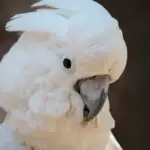 The Indian Ringneck or Ring-necked Parakeet does not lack assets. Its colorful plumage and its great robustness make it a bird very popular with breeders and individuals. Let’s find out about its main characteristics and everything it needs to live in captivity in excellent conditions.
The Indian Ringneck or Ring-necked Parakeet does not lack assets. Its colorful plumage and its great robustness make it a bird very popular with breeders and individuals. Let’s find out about its main characteristics and everything it needs to live in captivity in excellent conditions.
Ring-necked parakeet characteristics
Indian Ringneck ( Psittacula krameri ) belongs to the Psittacidae family and to the Psittaciformes order, the latter grouping together the tropical birds commonly known as parrots, lorises, or parakeets.
This Afro-Asian bird is now very common in Europe including France, especially in our southernmost regions where the Ring-necked Parakeet has returned to the wild, but it is also possible to see it in parks.
and gardens in Nancy, in the Paris region, or even in Lille. Since its introduction in Europe, in certain countries (Spain, England, the Netherlands, etc.) and more particularly in their large towns, the Ring-necked Parakeet has been considered an invasive species and competes with starlings, house sparrows, and other endemic passerines. is sometimes worrying.
There are four subspecies with different ranges.
- In Africa: (Psittacula krameri parvirostris)
- In Asia: Psittacula krameri Borealis .
Indian Ringneck Colours
The predominant color in the Ring-necked Parakeet is green, with some azure blue reflections on the tail, yellow under the wings, and on the belly.
The color of the plumage in the male is generally stronger than in the juveniles under 3 years and the female. In addition, only the male has a red stripe on his long tail and a black collar.
In adulthood, this bird weighs between 112 and 117 g, measures 41 cm in length at most, and has a wingspan of around 47 cm. In captivity, its life expectancy is around thirty years.
These parakeets congregate in groups both to breed and to forage. We, therefore, say that they are gregarious. They sleep in sort of dormitories that they abandon from March until October, a period during which they settle in the breeding sites.
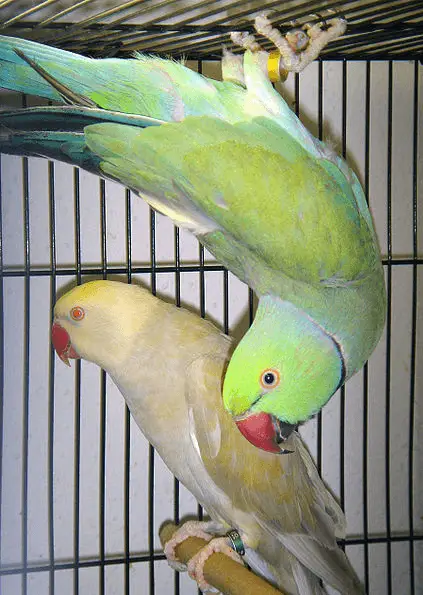
African ringneck female
Indian Ringneck Type
Wild Indian Ringneck parakeets are normally green in color, with the exception of turquoise blue on their tail feathers and the black and pink colored rings around the necks of males:
Indian ringneck blue

Indian ringneck violet
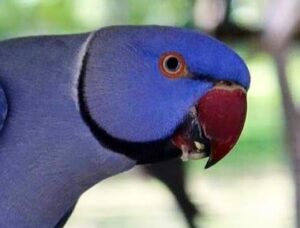
Indian ringneck yellow

Indian ringneck green

Indian ringneck white
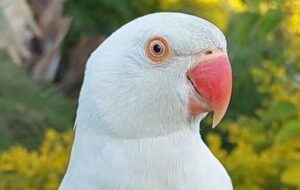
Indian Ringneck Diet
The Ring-necked Parakeet consumes only foods of plant origin such as seeds and a wide variety of local fruits, flowers, rice, berries, greens, legume sprouts, vegetables, quinoa, almonds, cereals. She does not hesitate to take advantage of the seeds that are placed in the bird feeders.
In France, the Rose-ringed Parakeet does not represent a plague for crops, unlike what we can reproach within Asia where this bird poses a real problem for fruit and cereal producers.
Rose-ringed parakeet reproduction
The rose reaches sexual maturity at the age of 3, more rarely from the age of 2. She only has one brood per year. Male and females make offerings during the nuptial period.
This parrot builds a nest in hollow trees. We, therefore, speak of cave nesting. The breeding season takes place in March-April. female lays 2- 5 eggs, she incubates for 20- 23 days.
After hatching, the young are naked, totally devoid of down. Their skin is all pink. They stay in the nest where they are beak fed by both parents. They begin to take flight after 41 days. However, they can live as a family until the next brood, that is, for a year.
Indian Ringneck Breeding
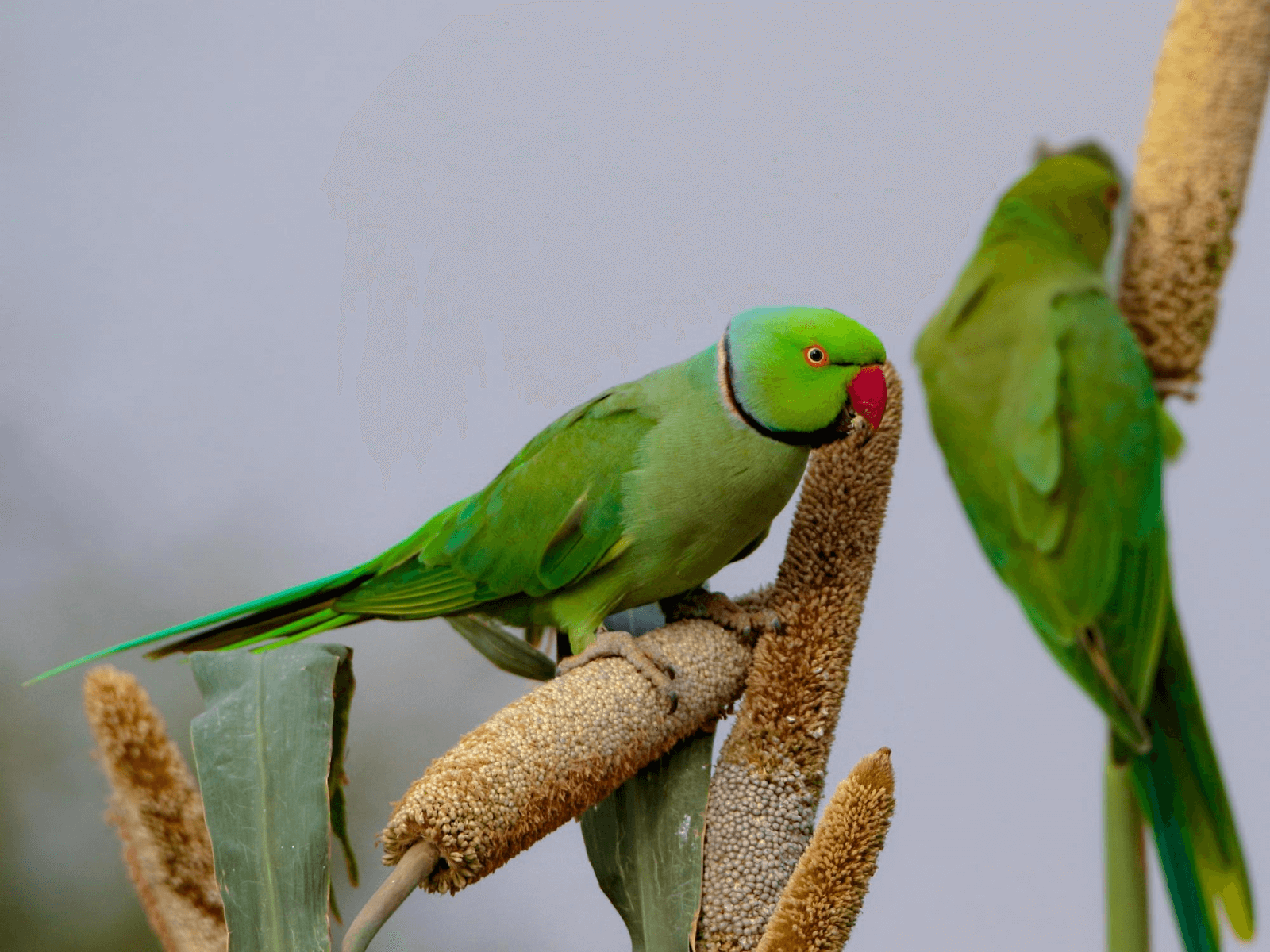
african ringneck parakeet
We appreciate the great hardiness of this easy-to-breed bird, which does not dispense with respecting good breeding practices. Thus the Ring-necked Parakeet in captivity needs:
- A very large metal aviary, the length of which must be at least 4 m for a couple.
- A water tank to meet your bathing needs, to be left in the aviary only during the summer.
- Two perches.
- A nesting box, at least 50 cm high and 30 x 30 cm. Its flight hole must have a diameter of 8 cm and the bottom must be covered with a good thickness of wood chips, about 6 cm. It should be cleaned regularly. It is therefore unnecessary to take it out of the aviary.
To feed his Ring-necked Parakeet, the breeder can obtain certain foods in a pet store (a mineral block, cuttlebone…) and a large part in his garden.
The ideal is to be able to bring him: vegetables, fruits, sprouted seeds, corn cobs, a mixture of non-germinated seeds, a breeding marsh, a complex of vitamins and minerals. Of course, care must be taken to ensure that the bird always has clean, fresh water available.
It is essential to give a dewormer to your parakeets, once a year at least.
The Ring-necked Parakeet is quite timid. She is also very exclusive and only places her trust in her master. She demands that he be attentive and present enough because she needs attention.
It is a very pleasant bird who, with a little patience, is able to learn to repeat words. You absolutely have to get her used to being taken in the hand by subjecting her to this type of contact every day. But despite all this attention, she will retain her wild instincts and can sometimes show aggression, especially if she is afraid.
Indian Ringneck for adoption
Although it is not easy to be 100% sure that you will choose a talking bird to adopt an Indian Rose-ringed Parakeet, you can definitely increase your chances.
Their voices are one of the most charming among companion parrot birds. It’s a comedic, high-pitched voice that’s sure to make you laugh and make sure they interact with you.
Indian Ringneck talking
In fact, these birds were once considered sacred in their homelands due to their remarkable speaking skills. No doubt, the clarity of speech that this species is known for has done a lot to increase the popularity of the species as pets both in India and globally.
Indian ringneck price
The price of an Indian ringneck parrot ranges between $400 and $5,000, depending on mutations
Indian ringneck Lifespan
Indian ringneck parrots live between 25 and 30 years
Are Indian ringneck parrots good pets?
Indian ringneck parrots still have a reputation of being nippy and difficult to tame but Indian Ringnecks, in my opinion, make excellent pets
Do Indian ringnecks talk?
They can learn to mimic the voices of different household members as well, the Indian Ringneck parakeet can learn up to 150-200 words
How long do Indian ringnecks live?
These parrots are reported to live for more than 30 years.
What do Indian ringneck parrots eat?
Indian ringnecks parrot eat fruits, vegetables, nuts, berries, and seeds


